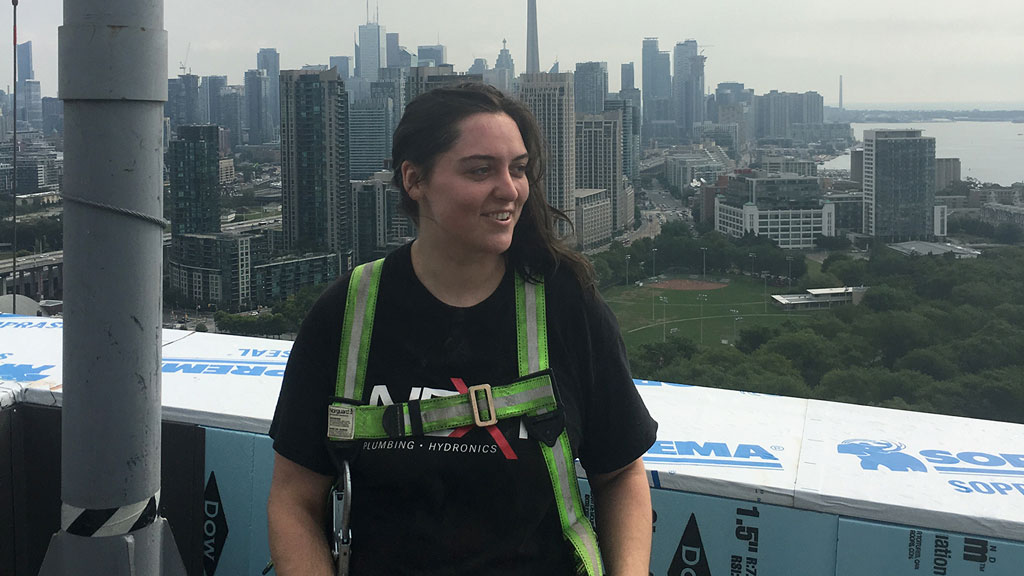Stronger together and pushing for systemic change.
That’s the force behind the Ontario Building and Construction Tradeswomen (OBCT) committee, a resource and support system for women building a career in the skilled trades since its launch in 2020.
Kayla Bailey, a journeyperson steamfitter, gasfitter, welder and a member of UA Local 46 Toronto, said being a member has many benefits to tradeswomen and also to the greater trades sector.
“Our individual experiences are not actually unique, but without knowing other tradeswomen it can often feel that way. It can be really isolating and can wreak havoc on your self-confidence and also on your mental wellbeing,” Bailey, a project manager for the OBCT, told the Daily Commercial News. “The OBCT connects women together and in doing so we are stronger, we’re able to push for equitable and systematic changes in the industry within our unions, within our companies and within our province and our country.”
The OBCT was started by a small steering group that came together for a tradeswoman summit during the Ontario Building Trades Convention in 2019.
“We’re working together to advocate for women and underrepresented gender identities in the skilled trades to ensure that they feel inspired, welcome, motivated, challenged, empowered, supported. Our goal is to build awareness among women in Ontario that a career in the trades is a great and viable option,” said Bailey. “We want to recruit them into apprenticeships and to support and retain women who are already working in the industry.”
Karen Pullen, an IBEW Local 353 electrician and business rep, is the chair of the committee and will also serve as OBCT rep on the executive board of the Building and Construction Trades Council of Ontario.
In the beginning, the committee was meeting in person but moved online during the pandemic which has allowed them to reach a wider audience.
“We actually started having a lot of women from northern Ontario join into the committee which is wonderful. So now it looks like we’re going to keep the committee online indefinitely,” said Bailey. “Having participation from women in northern Ontario is very important to us. We want to make sure that they realize that they are supported.”
The group, which now has almost 300 members, is funded through Ontario’s Skills Development Fund.
“Our members are potential, current and past women who work within the skilled trades,” said Bailey. “It’s open to all women and trades workers of underrepresented gender identities, pretty much anyone working in the construction industry who is a woman or another gender identity that is not male. Women on our committee are vast and diverse, they represent all trades, all sectors and all levels of representation.”
The OBCT runs training courses including mental health first aid, public speaking and presentation skills and Indigenous cultural competency training.
The mentorship program is especially important, explained Bailey, who was headed to university but changed her mind after going to work with her mom in a mine.
“The OBCT offers a comprehensive mentorship program for tradeswomen to learn and be supported by other tradeswomen,” said Bailey. “We do our best to make sure that we can connect them with women that are in the same trade.
“We created a community of women that support each other through not just the good times but also the bad times.”
OBCT is also working on a trades profile film project. The first videos feature Red Seal tradeswomen in welding, sheet metal, electrical and ironwork. The videos are expected to be released in the new year.
“The goal with this series of videos is to show men and women that are considering a career within the skilled trades the reality of each different trade so that they can make informed decisions regarding which trade they want to pursue in an apprenticeship,” Bailey said. “We also want to inspire women young and older to see that they can absolutely work in the trades and be successful.”
They have also developed surveys, one for tradeswomen, which is online now and one for contractors and employers, which is expected to be released in early 2022.
Breaking down barriers and attracting women to the industry can also help address the looming skilled trades shortage, she added.
“There is no shortage of women who want to start a career in construction but there are still many barriers, so if you want to get women into the skilled trades you need to do your part and help eliminate those barriers,” said Bailey.
For more information visit https://www.obctradeswomen.com/.
Follow the author on Twitter @DCN_Angela.











Recent Comments
comments for this post are closed